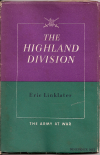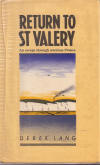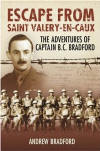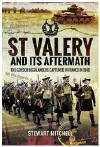|
This
page is dedicated to the Officers and Men of 51st
(Highland Division) who bravely and determinedly fought on
after the evacuation of the main British Expeditionary Force
(BEF) from Dunkirk in May 1940. Their sacrifice
has been overlooked too long and deserves its place in
history and our memories.
The
Battle Dress Insignia of the Highland Division
in 1940 was the
Saltire

 
"The 51st seems to have
been the only BEF formation to display a systematic
scheme of 'battle insignia' in varying brigade
colours. Veterans believe that the St Andrew's cross
divisional sign was worn in purple and green by Div
HQ, red by 152nd Bde and brown by 154th, the colour of
153rd is uncertain. Beneath the Saltire battalions
with brigades wore differing numbers and arrangements
of bars in matching colours; 7 A&SH wore a single
brown horizontal bar and 8 A&SH a vertical bar. In
152nd Bde the junior battalion, 4th Cameron
Highlanders, wore three thin horizontal bars below the
Saltire, all in red."
p 3 The
British Army 1939-45 (1) North West Europe published
in 2001 by Osprey Publishing
The Re-constituted Division wore the new badge below.

In May 1940
The 51st Division formed Saar Force, attached to the
Colonial Army Corps of the French 3rd Army, deployed on
the Maginot Line on the Saar River.


Initial
deployment 1940 and after German attack
In 1940 the regular 51st (Highland Division), with
cross-posted Territorial Units from the 9th Division,
and reinforced with units from the Royal Artillery,
Cavalry, Machine Gun Units, Infantry Sappers and
Royal Engineers was deployed as part of the British
Expeditionary Force (BEF) in France as the Saar Force on
the Saar River, under French command. After the
German Blitzkrieg on 10th May they withdrew to
Abbeville, as part of the French 9th Army. The
intention was to evacuate the Division from Le Havre,
and the 154th Brigade (re-named Ark Force) consisting of
the 1st Black Watch and 7th and 8th Argylls, were sent
there, but came under pressure from the encircling
Germany forces and after putting up fierce resistance
with some captured, eventually evacuated safely from Le
Havre* and
Cherbourg.
The remainder of the Division concentrated at St Valéry.
And so The 51st Division fought on in France after
the main part of the BEF had been evacuated from
Dunkirk
on 4th June. A fierce battle developed and The 2nd
and 4th Seaforth
Highlanders, 4th Cameron Highlanders, 1st and 5th Gordon Highlanders and the
4th Black Watch fought determinedly at St Valéry-en-Caux
until completely surrounded, out of ammunition and
supplies, and were overwhelmed by Rommel and ordered to
surrender on 12th June 1940. Some 10,000
were taken prisoner. These Regiments have St Valéry-en-Caux
as a
Battle
Honour.
Individuals who took part are remembered in the
Heroes of
St Valéry.
St Valéry Memorial 1950

I am
very grateful to
Jimmy Chisolm
for the above. His father Sgt Jim Chisolm of the 4th Battalion, The Queen's Own Cameron Highlanders,
was captured at
St Valéry and imprisoned in Oflag IIIC, where he became
Drum Major of the Camp Pipe Band. He took part in
the inauguration of the St Valéry Memorial in 1950, a
block of granite quarried near Balmoral. Sgt
Chisolm is 6th from the right in the photograph.
Photographs from Oflag IIIC from Jimmy Chisolm


The 51st Division Camp Pipe Band. Drum Major is Sgt. Jim
Chisholm of the Queen’s Own Cameron Highlanders. There
were four Pipe Majors in the Band with Pipe Major Bob
Hill the senior of the four. The second picture is from
the Camp Highland Games, unknown year.

The 51st Division PW on arrival. Seated front row centre
is Sgt. Jim Chisholm,
4th Bn Queen's Own Cameron Highlanders.
Additional source:
Scottish Units
in the World Wars by Mike Chappell ISBN: 9781855324695
*Julian
Roger
is trying to trace any surviving members of
the 7th and 8th Argyll and Sutherland Highlanders who,
separated from the rest of the Division, escaped from Le
Havre in the boat 'Margot II' 1940. His Great
Grandfather had the boat built for him and it still
exists as part on the 'Dunkirk Little Ships
Association' to reunite the people who travelled on her.
Contemporary Press Cuttings

LA
SEINE-MARITIME
Musical
Tribute

From the
Mairie at St Valéry 2010 © Dave Tierney
The
valour of the Highland Division is recalled in the pipe
tune "The Heroes of St Valéry" composed by
Pipe Major Donald MacLean of Lewis. He is said to
have based it on a folk song he heard at St Valéry.
The tune was first played at the Highland Brigade
gathering in Edinburgh in 1947.
The
Battlefield Band also perform a song written by their
late member,
Davy Steele, based on his uncle's experience at
St Valéry:
The
Beaches Of St Valéry
It was in 1940 the last days of Spring
We were sent to the Maginot line
A fortress in France built to halt the advance of an
army from a different time
For we were soon overrun out-fought and outgunned
Pushed further back every day
But we never believed high command would leave us
So we fought every inch of the way
Till the 51st Highlanders found themselves on the
banks of the Somme one more time
It still bore the scars of that war to end wars
The old soldiers scars deep in their minds
But we couldn't stay long for the Panzers rolled on
And the battle raged west towards the sea
Then on June the 10th when sapped of all strength
I entered St Valéry
Chorus
And
all I recall was the last boat leavin!
My brother on board waving and calling to me
And the Jocks stranded there wi' their hands in the
air
On the beaches of St Valéry
So I huddled all night in a hammered old house
As the shells and the bullets rained down
Next morning at dawn my hope was still strong
For we moved to the beach from the town
But the boat that had left on the day we arrived
Was the only one we'd ever see
And with no ammo or food we had done all we could
So we surrendered at St Valéry
Chorus
When
I returned at the end of the war
From the stalag where I'd been confined
I read of the battles the allies had fought
Stalingrad, Alamein, and the Rhine
Wi' pride in their hearts people spoke of Dunkirk
where defeat had become victory
But nobody mentioned the Highland Division
They'd never heard of St Valéry
Chorus
No
stories no statues for those that were killed
No honours for those that were caught
Just a deep sense of shame as though we were to
blame
Though I knew in my heart we were not.
So I've moved to a country I've come to call home
But my homeland is far o'er the sea
I will never return while my memories still burn
On the beaches of St Valéry
St
Valéry is perhaps most poignantly recalled in the
Scottish Dance
"The
Reel of the 51st" in which the dancers recreate
the
Saltire, Scotland's Flag
and the Battle Dress Badge of the Division. The
dance was created by the officers of 51st Highland
in their prison camp at Laufen during the long dark
days of captivity following 1940. During the reel
the couples balance in line twice forming the branches
of the Saltire, their Badge.
The variation of the reel that some use today breaking
the balance in-line and opting to turn their
partners twice in a wild manner recklessly eschews the
memory of its creators.
As at Athelstaneford in 832 AD, and Roslin in 1303
the Saltire was an inspiration against apparently
overwhelming odds.
The Seaforth Highlanders, now part of the
"Highlanders" Battalion of the new Royal
Regiment of Scotland (Seaforths, Camerons and Gordons)
were the local regiment of Caithness, and the natural
choice for all Sinclairs. Their particular
achievement at St Valéry in June 1940 is,
therefore, all the more important for us to remember.
After the regular division was captured the Territorial
9th (Highland) Division was re-named the 51st (Highland)
Division, and those who had escaped integrated to the re-constituted 51st
(Highland Division), with its new
badge, distinguished itself again
in in North Africa as part of the 8th Army, then in
Italy and in 1944 at the
Orne Bridgehead,
after the Allies landed in Normandy, and was allowed the
satisfaction of liberating St Valéry.
French Commemorative Site:
Saint-Valéry-en-Caux,
The First Battle
of Normandy

"AT
THE GOING DOWN OF THE SUN, AND IN THE MORNING,
WE WILL REMEMBER THEM"
www.51hd.co.uk - the Official 51 Highland
Division Website and Online Museum - Read our detailed History and browse
photographs, maps and personal accounts from those who fought with the 51HD
Make
a donation to the Army Benevolent Fund in Scotland
Picture
of Monument at Falaise d'Amont
See
also "Scots at War"
Books on
the 51st (Highland) Division in
1939 and 1940







|